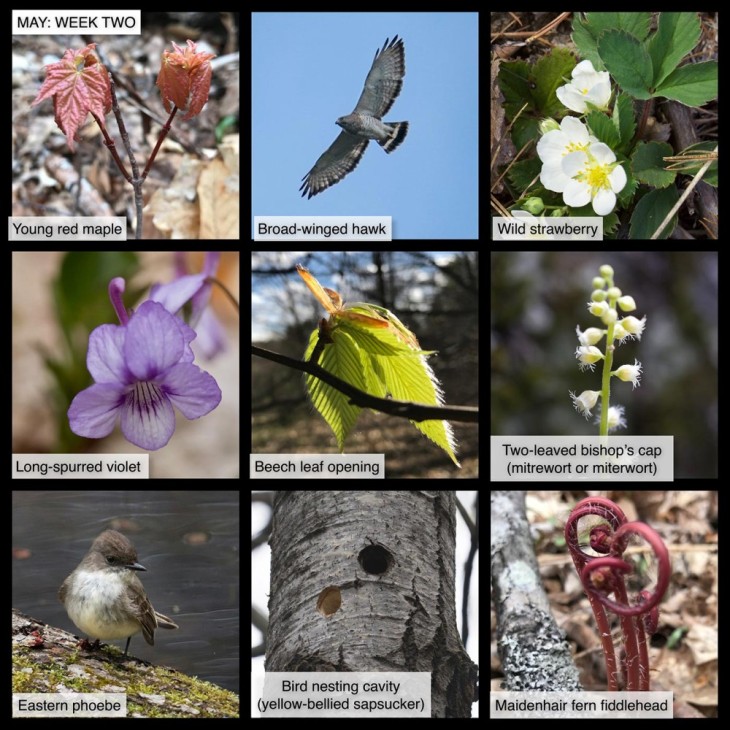This week in the woods, the forest floor is still sunny, but new leaves on our hardwoods are becoming more noticeable. Look for the glossy red leaves of last year’s red maple seedlings; they’ve been hiding under the snow and are now making a push for the sky. American beech leaves are emerging; they’re pale green and jewel-like in the sun. If you open a bud, how many leaves do you find? Here’s a recent article about the tree by Olivia Box, from our Outside Story series.
Broad-winged hawks have been back for a few weeks now, but in the past several days, we’ve noticed mating displays – flirtatious circling, and in one case, a sharp dive down into the woodsy edge of a field. These are common hawks and (for hawks…) easy to identify; look for them hunting over fields and meadows, and notice this combination of an underside view: pale wings with black edges and a boldly striped tail. Their “kee kee” call is also distinctive. Here’s an Audubon species description, including a recording of their call.
There are two kinds of native strawberry plants blooming this spring, wild strawberry, which is more common, and woodland strawberry. One way to tell the two apart is the size of the central leaf tooth. Here’s a link from the U.S. Forest Service discussing the two species. Or just call it a strawberry and declare yourself done.
We’ve found (at least) four different violets in bloom, with more on the way. Identifying individual species can be tricky; one that we’ve noticed this week is long-spurred violet. It gets its name from the length of the back spur on its lowest petal. According to the Ladybird Johnson Wildflower Center this violet is “often associated with hemlocks.”
Another wildflower joining the show this week is tiny two-leaved bishop’s cap (mitrewort). This is one of those little flowers you can walk by a hundred times and never notice, but it’s exquisite on close inspection. Mary Holland, as usual, is a great source of information and images.
Chances are high that you don’t have to go into the woods to find an eastern phoebe. It’s probably nesting over your most-used door. Here’s a wonderful article by Carolyn Lorie from our Outside Story series, describing her own experience with the birds, and the concept of “site fidelity.”
Cavity trees provide homes for a variety of wildlife, including many birds. Some birds accept what’s available; others chisel away at a hole to widen it, still others excavate their own. These two holes were made by yellow-bellied sapsuckers. The old, darker hole to the right in the photo was excavated last year. This year, the birds are setting up their nursery on the other side of the tree. Here’s an article from our archive by Susan Morse, with images of different species’ cavity holes.
Finally, this past weekend’s surprise snowfall made some new growth on the forest floor really glow against the white. One of these was the red curlicue fiddlehead of maidenhair fern. Here’s an article by Michael Snyder, explaining how this fern is an indicator species for, “the kind of soils that grow the sugar maples of dreams.”
In this difficult period, many of us find joy in observing local nature, and many families are seeking outdoor enrichment opportunities for children. Here are nine photographs taken this past week in forests within 15 miles of the Northern Woodlands office in Lyme, New Hampshire. We hope you enjoy using this grid as a prompt for your own explorations, or as the basis for a game of family forest tic-tac-toe.
What are you seeing in the woods this week? Share your images with us on Facebook, or submit a special photo for possible inclusion in our monthly online Reader Photo Gallery.



Discussion *